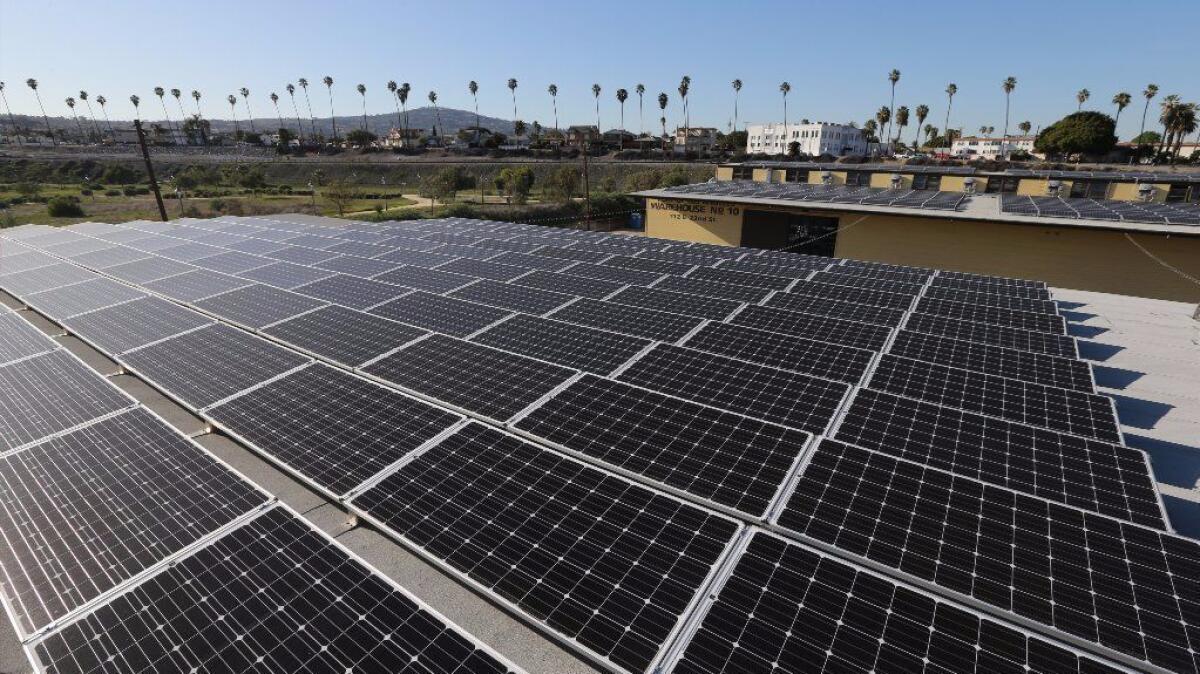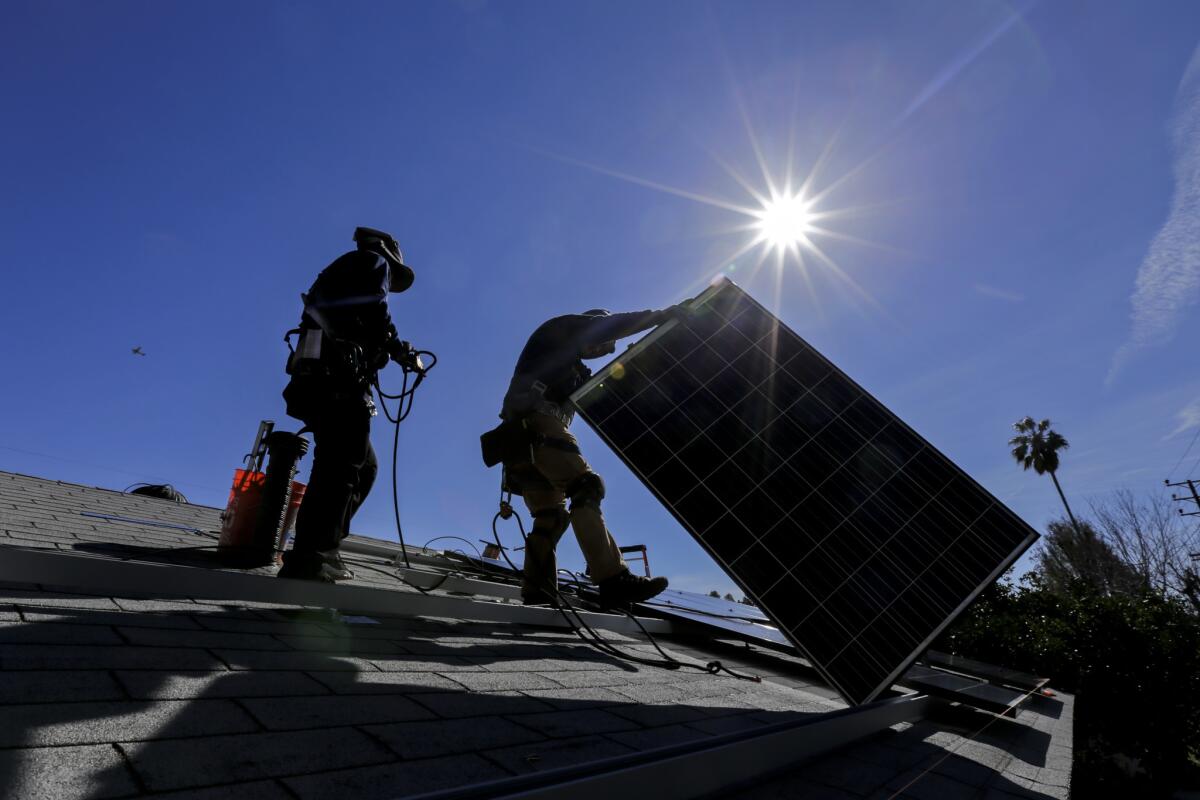A trade flap is roiling the solar industry — and Trump may have the final word

A battle is coming to a head that may have major implications for the solar energy industry.
In one corner is a bankrupt maker of solar panels from Georgia that says a flood of inexpensive imports from China and other countries is harming U.S. solar equipment manufacturers and a global tariff needs to be imposed.
In the other corner is just about every other sector of the industry, saying a hike in the price of solar panels will lead to a dramatic downturn in sales that will result in thousands of lost jobs, especially in California.
Ultimately, the decision may end up in the hands of President Trump.
“This is a big deal,” said Morten Lund, a San Diego attorney who specializes in energy cases for the Stoel Rives law firm. “I guarantee you, anybody that works in solar at any level above hammer and nail knows about this. In my daily news briefing, it’s the top story every day.”
At the center of the dispute is a company named Suniva. Based outside of Atlanta, it made high-efficiency solar cells and modules and was considered an industry success story. The company that employed 350 workers was praised by the Obama administration and last year was named Georgia’s manufacturer of the year.
But in April, Suniva filed to reorganize under Chapter 11 of the U.S. bankruptcy code, complaining that competitors in Southeast Asia have driven prices so low that the company could not make a profit. By some estimates, prices of panels have dropped 60% in the last five years.
“U.S. solar manufacturing jobs and the industry as a whole are on the brink of extinction,” Suniva’s executive vice president of commercial operations, Matt Card, said in an email.
Just days after the bankruptcy announcement, Suniva filed a petition with the U.S. International Trade Commission calling for a price floor of 78 cents a watt for solar panels made outside the United States and import duties of 40 cents a watt on solar cells.
Experts say solar cells sell for 25 cents to 33 cents a watt.
“Suniva believes that with a global safeguard, all aspects of the U.S. solar industry — including manufacturing and its research and development — will have the opportunity to succeed,” Card said.
But critics within the solar industry say imposing tariffs will have negative effects across the business chain.
“We think it would cut demand significantly and create job losses all across the country,” said Abigail Ross Hopper, president and CEO of the Solar Energy Industries Assn., the industry’s biggest trade group. “This has the potential to be devastating.”
The solar industry employs an estimated 260,000 workers nationwide, with California accounting for more than one-third of that amount.
Forecasting that 88,000 jobs, including 15,800 in California, would disappear if the ITC grants Suniva’s petition, the solar trade group says increased prices for panels will scare homeowners away from installing rooftop solar systems and make utility-scale projects less affordable.

There’s also a potential political element involved in the case.
When Suniva filed its petition with the ITC, it invoked a little-used provision in trade cases called Section 201. Rather than basing a complaint against a specific country — such as China — Section 201 cases look to determine if a “global safeguard” is warranted.
According to the rules, if the ITC decides domestic solar manufacturers deserve sweeping protection and recommends relief, its findings are then passed on to the U.S. president, who has final say.
Since President Trump has long complained about trade policies with China hurting U.S. manufacturers, there is plenty of speculation that should the ITC rule in Suniva’s favor, Trump will OK the tariffs.
The last time a president accepted a Section 201 recommendation from the ITC was in March 2002, when George W. Bush imposed a tariff on steel. He lifted the tariff in December 2003.
“We have a president who clearly likes tariffs and doesn’t like China and is not afraid of isolationist trade policies,” Lund said. “Also, he doesn’t have to follow the recommendation of the ITC. They might recommend a 79-cent price and he could put in a $2 minimum price.”
Another financially ailing solar manufacturer, SolarWorld, earlier this month joined Suniva as a co-petitioner in the case.
SolarWorld has gone to the ITC twice, complaining about trade dumping, and won each time, although the company did not invoke Section 201.
Tim Brightbill, SolarWorld’s trade attorney, says the predictions of thousands of job losses nationally and in California are overblown.
Critics earlier “claimed putting duties on China would lead to 50,000 American job losses in solar installation.” Brightbill said. “That never happened. Instead, demand for solar continued to increase, solar installations continued to increase and solar jobs continued to increase.”
But SEIA’s Ross Hopper said Suniva and SolarWorld should have filed an anti-dumping case, rather than employing Section 201.
“I’m not persuaded that this method, this broad stroke and blunt instrument, is the right way to go about this,” Ross Hopper said.
ITC commissioners will hold a hearing Aug. 15 at their headquarters in Washington, where the parties involved will make their cases. The ITC will vote on the merits of the case by Sept. 22 and both sides are looking at the date anxiously.
“We cannot just be a nation of installers of foreign solar panels,” Brightbill said. “If we want the next generation of solar products to be developed here in the United States, then we have to have manufacturing as an important part of our solar industry.”
Opponents say the real economic punch will be particularly felt in California.
“California has the most number of people employed in the solar industry because you have the most amount of solar,” Ross Hopper said. “So the impact is pretty significant in your state. … If you’re in the solar industry, your livelihood is at risk.”
Card said Suniva has based its argument on the fact that solar cells and modules are being shipped to the United States from all over the world, not just from one or two countries.
“Once U.S. solar manufacturing jobs and the industry as a whole are gone, they are not likely to come back because the investment in the industry will dry up, leaving behind only fluctuating project-to-project and part-time construction jobs for solar panel installation,” Card said.
Ross Hopper said she would “push back on the narrative that manufacturing is on the decline,” pointing to a census conducted by the Solar Foundation that reported there are 38,000 workers in solar manufacturing in the United States. “We actually have cell and module manufacturers in our organization, so they are similarly situated with Suniva and SolarWorld, and they are opposing this case.”
For now, Suniva’s factories are idle, but Card said they can be restarted if the ITC and Trump rule in the company’s favor.
“People [in the solar industry] are quick to say that something must be done to protect U.S. manufacturing, but when it comes to ideas on how to do that, all we hear is silence,” Card said.
The ITC case comes at a crucial moment for solar.
The industry has been boosted by a 30% federal tax credit, but those supports are scheduled to be reduced. The credit drops to 26% in 2020, 22% in 2021 and 10% in 2022 and beyond.
Generation from rooftop and other small-scale solar projects across the country nearly doubled between 2014 and 2016 and utility-scale installations have gone up 72% between 2010 and 2016, according to the U.S. Energy Information Administration.
“As prices have come down, solar is the economically rational decision so we can compete on price against wind, against natural gas, against other forms of fuel,” Ross Hopper said. “Obviously, if you change the input on the price and double the price of solar panels, it’s not going to be an economic option.”
More to Read
Inside the business of entertainment
The Wide Shot brings you news, analysis and insights on everything from streaming wars to production — and what it all means for the future.
You may occasionally receive promotional content from the Los Angeles Times.










